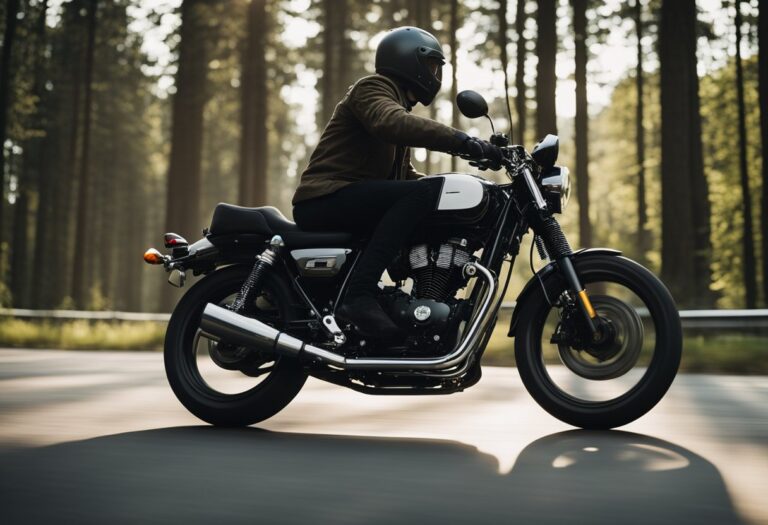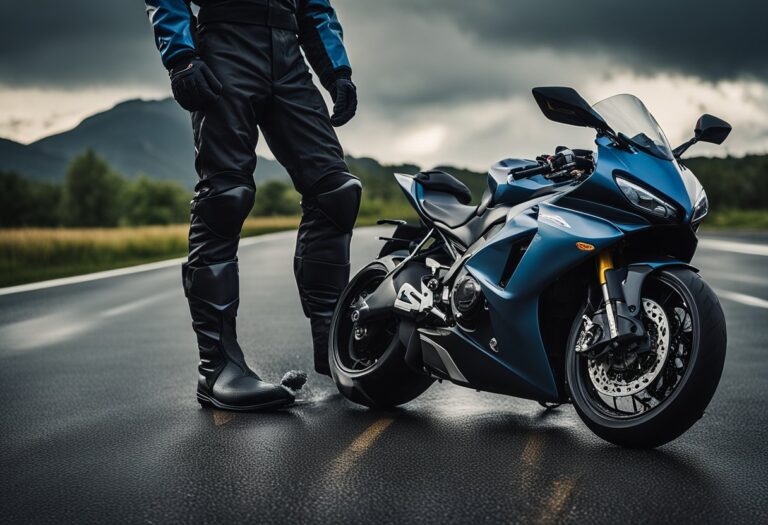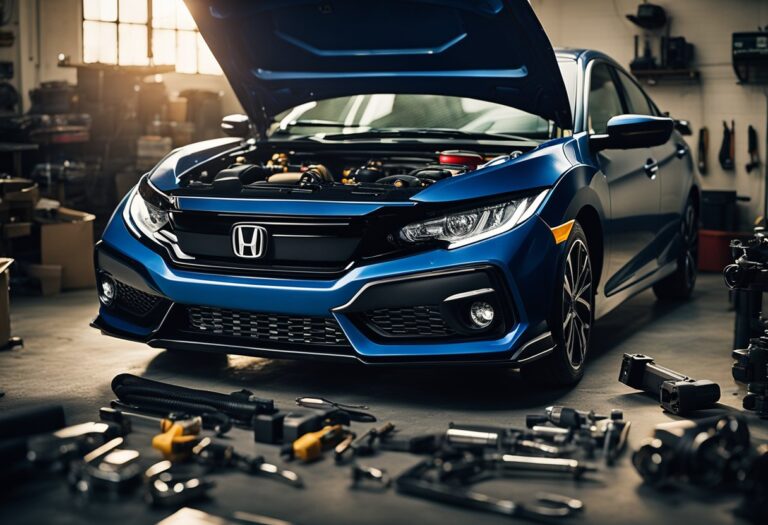Top Performance Tires for Summer Driving: Our Recommendations for Maximum Grip and Control on the Road
Summer is the perfect time for road trips, cruising around town, and enjoying the warm weather. However, it’s important to ensure that your vehicle is equipped with the right set of tires to handle the hot and dry conditions. High-performance summer tires are designed to provide superior grip and handling on both wet and dry roads, making them an ideal choice for summer driving.

When it comes to performance tires, there are a variety of options available on the market. From top brands to key features, it can be overwhelming to choose the right set of tires for your vehicle. This article will provide an overview of the top performance tires for summer driving, highlighting the benefits of these tires, key features to consider, and safety tips for optimal performance.
Key Takeaways
- High-performance summer tires provide superior grip and handling on both wet and dry roads, making them an ideal choice for summer driving.
- Top brands for performance summer tires include Michelin, Bridgestone, and Goodyear.
- Key features to consider when choosing performance summer tires include tread design, compound, and size.
Benefits of High-Performance Summer Tires

High-performance summer tires are designed to provide superior handling, braking, and cornering performance on dry and wet roads. These tires are made from advanced rubber compounds and have unique tread patterns that allow them to grip the road better than regular tires. Here are some of the benefits of using high-performance summer tires:
1. Improved Handling
High-performance summer tires offer excellent handling capabilities, giving drivers more control over their vehicles. These tires have a stiffer sidewall, which helps to reduce tire flex during cornering, resulting in better stability and more precise steering.
2. Better Braking Performance
Summer tires are designed to provide better braking performance on dry and wet roads. They have a larger contact patch, which increases the amount of rubber in contact with the road, resulting in better grip and shorter stopping distances.
3. Enhanced Cornering Performance
High-performance summer tires have a unique tread pattern that allows them to maintain their grip on the road during cornering. This feature helps to reduce the risk of skidding or sliding, resulting in safer and more confident driving.
4. Improved Traction
Summer tires are made from advanced rubber compounds that provide better traction on dry and wet roads. These tires have a softer tread compound, which helps to increase the amount of grip between the tire and the road, resulting in better acceleration and improved handling.
In summary, high-performance summer tires offer a range of benefits that can improve the performance and safety of your vehicle. With their superior handling, braking, and cornering capabilities, these tires are an excellent choice for drivers who want to enjoy a more engaging and confident driving experience.
Top Brands for Performance Summer Tires

When it comes to performance summer tires, there are several top brands that stand out from the rest. These brands have a reputation for producing high-quality tires that provide excellent grip and handling, making them a popular choice among car enthusiasts and professionals alike.
Michelin
Michelin is a well-known brand in the tire industry and is known for producing some of the best performance summer tires on the market. Their tires are designed to provide excellent grip and handling, even in wet conditions, making them a popular choice among drivers who demand the best.
Bridgestone
Bridgestone is another top brand when it comes to performance summer tires. Their tires are designed to provide excellent handling and stability at high speeds, making them a popular choice among sports car enthusiasts. Bridgestone also offers a range of tires that are specifically designed for different types of vehicles, including high-performance cars and SUVs.
Continental
Continental is a German brand that has been producing high-quality tires for over 140 years. Their performance summer tires are designed to provide excellent grip and handling, even in wet conditions, making them a popular choice among drivers who demand the best. Continental also offers a range of tires that are specifically designed for different types of vehicles, including sports cars and SUVs.
Pirelli
Pirelli is an Italian brand that has been producing high-performance tires for over 140 years. Their performance summer tires are designed to provide excellent grip and handling, even in wet conditions, making them a popular choice among drivers who demand the best. Pirelli also offers a range of tires that are specifically designed for different types of vehicles, including sports cars and SUVs.
Overall, these four brands are among the best when it comes to performance summer tires. Each brand has its own unique features and benefits, so it’s important to choose the right tire for your specific needs and driving style.
Key Features of Performance Summer Tires

Tread Patterns
Performance summer tires have unique tread patterns that are designed to provide maximum grip on dry and wet roads. These tires typically have wider and shallower grooves than all-season tires, which allows for more rubber to be in contact with the road. The tread patterns also have a higher number of blocks, which helps to increase the tire’s contact patch and improve handling. The tread patterns on performance summer tires are optimized for dry performance, but they also have enough water evacuation channels to provide good wet traction.
Rubber Compounds
The rubber compounds used in performance summer tires are specifically designed to provide maximum grip and handling in warm weather conditions. These tires use a softer rubber compound than all-season tires, which allows them to conform to the road surface and provide better grip. However, this softer rubber compound also means that performance summer tires wear out faster than all-season tires. Some manufacturers use advanced rubber compounds that are designed to provide both excellent grip and long tread life.
Tire Construction
Performance summer tires are constructed with high-performance materials that are designed to withstand the high speeds and stresses that come with aggressive driving. These tires typically have a stiffer sidewall than all-season tires, which helps to improve handling and stability. They also have a lower profile than all-season tires, which allows for better steering response and cornering ability. Performance summer tires are often constructed with advanced materials such as Kevlar or carbon fiber, which help to reduce weight and improve performance.
In summary, performance summer tires are designed to provide maximum grip and handling in warm weather conditions. They have unique tread patterns, specialized rubber compounds, and advanced tire construction that make them ideal for high-performance driving. However, they do wear out faster than all-season tires and are not recommended for use in cold or snowy conditions.
Performance Tires vs. All-Season Tires

When it comes to choosing the right tires for your vehicle, it’s important to consider the driving conditions you’ll be facing. Two common options are performance tires and all-season tires. While both types have their benefits, there are some key differences to keep in mind.
Performance Tires
Performance tires are designed for high-speed driving and optimal handling in dry conditions. They typically have a lower profile and wider tread than all-season tires, allowing for better grip on the road. The rubber compound used in performance tires is also designed to provide maximum traction and responsiveness.
However, performance tires are not ideal for all driving conditions. They are not recommended for use in snowy or icy conditions, as the rubber compound can become hard and lose traction. They also tend to wear out faster than all-season tires, due to their softer rubber compound and increased grip.
All-Season Tires
All-season tires are designed to provide good performance in a variety of conditions, including dry, wet, and light snow. They have a more versatile tread pattern than performance tires, with deeper grooves and sipes that provide better traction in wet and snowy conditions.
While all-season tires may not provide the same level of grip and handling as performance tires in dry conditions, they are a more practical choice for everyday driving. They also tend to last longer than performance tires, due to their harder rubber compound and less aggressive tread pattern.
In summary, the choice between performance tires and all-season tires ultimately comes down to the driving conditions you’ll be facing. If you prioritize speed and handling in dry conditions, performance tires may be the way to go. However, if you need a more versatile tire that can handle a variety of conditions, all-season tires are likely the better choice.
Tire Maintenance and Care for Optimal Performance

Proper tire maintenance is crucial for ensuring optimal performance and longevity of your tires. Here are some important tips to keep your tires in top condition:
Check Tire Pressure Regularly
Maintaining the correct tire pressure is essential for safety, fuel efficiency, and tire longevity. It is recommended to check tire pressure at least once a month and before long trips. Use a tire pressure gauge to ensure the pressure matches the manufacturer’s recommendations, which can be found in the owner’s manual or on the tire sidewall.
Rotate Tires
Rotating tires regularly helps to distribute wear evenly and extend the life of your tires. It is recommended to rotate tires every 6,000 to 8,000 miles or as recommended by the manufacturer.
Check Tread Depth
Tread depth is important for maintaining traction and handling in wet and dry conditions. Use a tread depth gauge or the penny test to ensure the tread depth is not below the minimum recommended by the manufacturer. If the tread is too low, it is time to replace the tire.
Avoid Overloading
Overloading your vehicle can cause excess stress on your tires, leading to premature wear and potential blowouts. Check the manufacturer’s recommendations for maximum load capacity and avoid exceeding it.
Store Tires Properly
When storing tires, keep them in a cool, dry place away from direct sunlight and sources of heat. Avoid stacking tires or placing heavy objects on top of them, which can cause deformation and damage.
By following these simple maintenance tips, you can ensure your tires perform at their best and provide a safe and comfortable driving experience.
Understanding Tire Specifications

Load Index
The load index of a tire is a numerical code that indicates the maximum weight that the tire can support when it is inflated to its recommended pressure. The load index is usually located on the sidewall of the tire and is represented by a number that ranges from 0 to 279. The higher the load index number, the more weight the tire can support.
It is important to choose a tire with the correct load index for your vehicle to ensure safe and optimal performance. Overloading a tire can cause it to overheat and fail, which can lead to a dangerous situation on the road.
Speed Rating
The speed rating of a tire is a letter code that indicates the maximum speed that the tire can safely travel when it is properly inflated and loaded. The speed rating is also located on the sidewall of the tire and is represented by a letter that ranges from A to Y. The higher the speed rating letter, the higher the maximum speed the tire can safely handle.
It is important to choose a tire with the correct speed rating for your vehicle and driving style. Using a tire with a lower speed rating than what is recommended can result in poor handling and dangerous situations, while using a tire with a higher speed rating than necessary can be unnecessary and costly.
Overall, understanding tire specifications such as load index and speed rating is crucial for selecting the right tire for your vehicle and driving needs. Be sure to consult your vehicle’s owner manual and a qualified tire professional to ensure you are making an informed decision.
Safety Tips for Summer Driving with Performance Tires

When it comes to summer driving, having performance tires can make a huge difference in your car’s handling and acceleration. However, it’s important to remember that performance tires are designed for high-speed driving and may not perform as well in wet or slippery conditions. Here are some safety tips to keep in mind when driving with performance tires during the summer months:
1. Check Tire Pressure Regularly
Performance tires require a specific amount of air pressure to perform at their best. It’s important to check your tire pressure regularly, at least once a month, to ensure that they are properly inflated. Underinflated tires can cause poor handling, decreased fuel efficiency, and even tire failure.
2. Avoid Driving on Wet or Slippery Roads
Performance tires are designed for dry conditions and may not perform as well in wet or slippery conditions. It’s important to avoid driving on wet or slippery roads whenever possible, especially if you’re driving at high speeds. If you must drive on wet or slippery roads, reduce your speed and drive with caution.
3. Slow Down in Hot Weather
High temperatures can cause your tires to heat up and increase the risk of a blowout. It’s important to slow down and drive with caution in hot weather, especially if you’re driving on highways or other high-speed roads.
4. Rotate Your Tires Regularly
Rotating your tires regularly can help ensure even wear and prolong the life of your tires. It’s recommended to rotate your tires every 5,000 to 8,000 miles, or as recommended by your tire manufacturer.
By following these safety tips, you can help ensure that your performance tires perform at their best and keep you safe on the road during the summer months.
How to Choose the Right Performance Tires for Your Vehicle

Choosing the right performance tires for your vehicle can be a daunting task, but it doesn’t have to be. Here are some factors to consider when selecting the best performance tires for your car:
1. Tire Size
The first thing to consider when choosing performance tires is the size of your vehicle’s tires. It’s important to choose tires that are the same size as your current ones or ones that are recommended by your vehicle’s manufacturer. This ensures that the tires will fit properly and won’t cause any issues with your car’s performance.
2. Tread Pattern
The tread pattern of a tire is another important factor to consider when selecting performance tires. Tires with a good tread pattern offer better traction and handling on the road. Look for tires with a tread pattern that is suitable for the type of driving you do. For example, if you do a lot of highway driving, look for tires with a tread pattern that provides good traction on dry roads.
3. Speed Rating
Another important factor to consider when choosing performance tires is the speed rating. The speed rating indicates the maximum speed that the tire can handle safely. Make sure to choose tires with a speed rating that is suitable for the type of driving you do.
4. Temperature Rating
The temperature rating is another important factor to consider when selecting performance tires. The temperature rating indicates the tire’s ability to dissipate heat. Look for tires with a temperature rating that is suitable for the type of driving you do.
5. Brand Reputation
Lastly, consider the reputation of the tire brand you are considering. Look for brands that have a good reputation for producing high-quality performance tires. This will ensure that you are getting a reliable and durable product that will last you for many miles to come.
By considering these factors, you can choose the right performance tires for your vehicle and enjoy a safe and comfortable driving experience.
Frequently Asked Questions

What are the characteristics of the best summer performance tires for 2024?
The best summer performance tires for 2024 are designed with a few key characteristics in mind. They typically have a softer rubber compound that provides excellent grip on dry roads and in high temperatures. They also have a tread pattern that is optimized for dry performance, with larger blocks and fewer grooves than all-season tires.
How do ultra high performance summer tires differ from all-season tires?
Ultra high performance summer tires differ from all-season tires in a few key ways. They have a softer rubber compound that provides better grip in warm weather, but they are not designed for use in cold or snowy conditions. They also have a more aggressive tread pattern that is optimized for dry performance, with larger blocks and fewer grooves than all-season tires.
What are the top-rated ultra high performance tires for daily driving?
The top-rated ultra high performance tires for daily driving are those that provide excellent grip and handling in warm weather, but also offer good comfort and low noise levels for everyday use. Some of the top-rated tires in this category for 2024 include the Michelin Pilot Sport 4S, the Bridgestone Potenza S-04 Pole Position, and the Continental ExtremeContact Sport.
What benefits do summer performance tires offer compared to standard tires?
Summer performance tires offer several benefits compared to standard tires. They provide better grip and handling in warm weather, which can improve safety and performance. They also have a more aggressive tread pattern that is optimized for dry performance, which can improve acceleration and braking. Additionally, summer performance tires tend to have a longer lifespan than all-season tires, as they are not designed for use in cold or snowy conditions.
How do I choose the right performance tires for my vehicle during summer?
When choosing performance tires for summer driving, it is important to consider a few key factors. First, consider the type of driving you will be doing, as some tires are better suited for track use than daily driving. Second, consider the size and specifications of your vehicle, as not all tires will fit or be appropriate for your particular make and model. Finally, consider your budget, as high-performance tires can be more expensive than standard all-season tires.
What should I look for in tires to ensure top performance in dry and wet summer conditions?
To ensure top performance in dry and wet summer conditions, look for tires with a soft rubber compound that provides excellent grip on dry roads, but also has good wet traction. Additionally, look for tires with a tread pattern that is optimized for both wet and dry performance, with enough grooves to channel water away from the tire’s surface. Finally, consider the tire’s size and specifications, as well as your driving style and budget, when making your selection.






